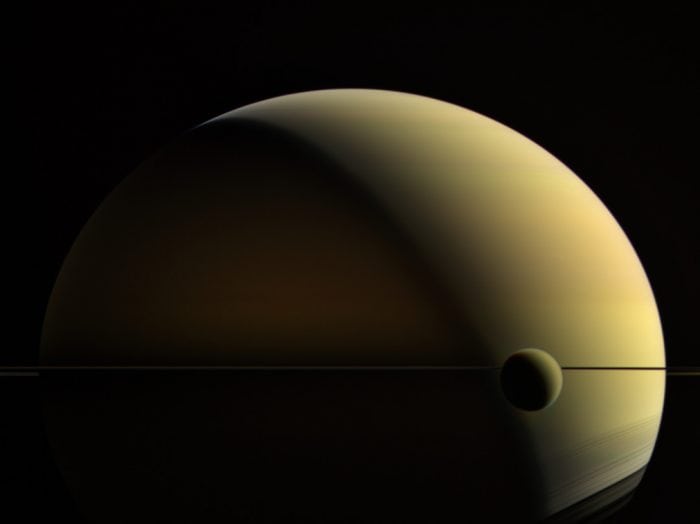
Titan, the largest satellite of Saturn’s system, is famous for being entirely covered by layers of thick orange haze, which are composed of organic aerosols. These organic particles are produced through various kinds of reactions in Titan’s methane-rich reducing atmosphere, driven by solar ultraviolet light and Saturn’s high-energy particles.

Figure 1. (Left) Titan observed by Cassini spacecraft on September 21st, 2005, from the altitude of 213 thousand km. Image Credit: NASA/JPL/Space Science Institute. (Right) Imaginary drawing of an ancient Earth covered by orange haze layers. Image Credit: NASA’s Goddard Space Flight Center/Francis Reddy.
Since ancient Earth 2.5 billion years ago, before the rise of oxygen levels due to photosynthetic organisms, Earth may have had a methane-rich reducing atmosphere similar to today’s Titan. Ancient Earth might have been covered by orange haze layers which could supply precursor materials for life. In addition, because organic hazes can absorb and scatter solar light, they play an important role in controlling the global climate. Therefore, studying the formation process of organic aerosols could provide knowledge not only of the origin of life but also of the behavior of the atmospheric system.
Although NASA and ESA’s Cassini-Huygens mission, operated from 1997 until 2017, have revealed many of the production process of organic aerosols in Titan’s atmosphere, there still remain many questions that need to be answered. In particular, we do not know how aerosol particles coagulate and grow through Titan’s middle atmosphere (corresponding to 700 – 150 km altitude). Unlike Titan’s upper atmosphere (higher than about 1000 km), where large hydrocarbon molecules are produced by numerous ion reactions driven by extreme ultraviolet (EUV) and high-energy particles, far ultraviolet (FUV) has relatively longer wavelengths (120 – 300 nm) and is the dominant energy source in the middle atmosphere.
This is particularly important when considering early Earth, because, on early Earth, FUV would also be the dominant source for driving the production of organic aerosols. Previous studies, however, used only EUV and high-energy particles; thus, using FUV to simulate the physical and chemical processes in middle atmospheres is more important when it comes to understanding the climate of ancient Earth. In addition, surface reactions are expected to occur in middle atmospheres, which have not been paid much attention before.
A research group led by Peng Hong of Chiba Institute of Technology has developed an H2/He lamp that can irradiate FUV light similar to the solar spectrum and simulated organic aerosol production in their laboratory by radiating the FUV to methane-CO2 gas mixtures. They measured the production rate of organic aerosols and analyzed the chemical composition of solids and gases. They found aerosol’s growth rate dropped significantly for CO2-rih conditions, similar to an early Earth, and found that the produced organic aerosols are mainly composed of aliphatic carbons unlike previous experiments using EUV and high-energy particles, suggesting that gaseous polymerization reactions previously assumed as the dominant reactions for the production of monomers may not be efficient for making solid particles from gases.
In order to confirm this, they developed a numerical model to simulate the chemical reactions inside the chamber and found that CH3 addition, a kind of heterogeneous reactions which occur on the surface of solids, are more efficient than polymerization reactions of hydrocarbons in the gas phase.

Figure 2. (Left) Schematic diagram of the instruments of aerosol experiments. Image credit: Hong et al. (2018) (Top right) Radiating FUV (right) to the reaction cell (left). (Bottom right) Organic aerosol produced on the MgF2 window. Modified with permission from Elsevier from https://doi.org/10.1016/j.icarus.2018.02.019 and from JAAST from: https://doi.org/10.11203/jar.31.185
These results suggest that in Titan’s middle atmosphere, heterogeneous reactions would be the main process for the growth of aerosol particles and organic aerosol layers in early Earth would have been thinner than previously estimated. As planets having methane-rich reducing atmospheres are very common in the universe, including Pluto (recently explored by the New Horizons mission) and exoplanets, knowledge obtained by this study would be applicable to those planets.

Figure 3. Schematic diagram of the aerosol formation process in Titan’s atmosphere. In the frame on right shows the growth process on which this study particularly focused. Modified with permission from Elsevier from https://doi.org/10.1016/j.icarus.2018.02.019 and from JAAST from: https://doi.org/10.11203/jar.31.185
These findings are described in the article entitled Experimental study of heterogeneous organic chemistry induced by far ultraviolet light: Implications for growth of organic aerosols by CH3 addition in the atmospheres of Titan and early Earth, recently published in the journal Icarus. This work was conducted by Peng Hong from the Chiba Institute of Technology and The University of Tokyo, and Yasuhito Sekine, Tsutoni Sasamori, and Seiji Sugita from The University of Tokyo.









